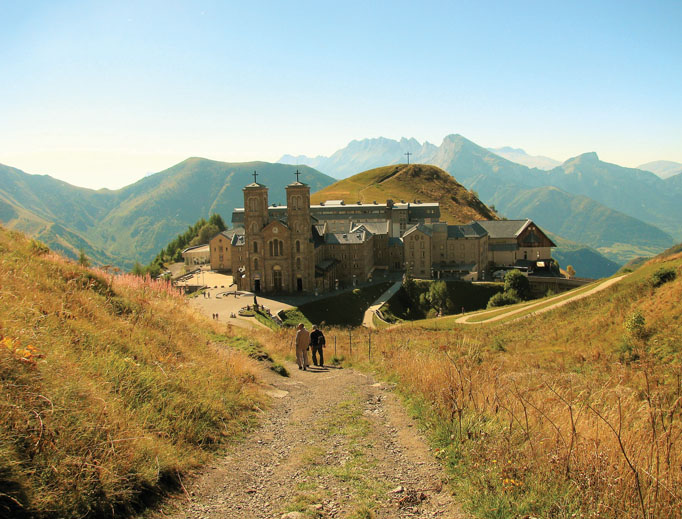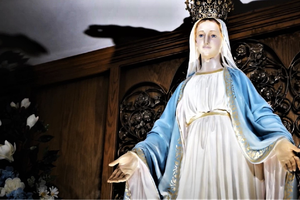Weeping Mother: Our Lady of La Salette Calls for Prayer and Repentance in the Alps
Marian apparition in France remains relevant.

On a golden Saturday afternoon on Sept. 19, 1846, two children were tending their cattle on the grassy slopes at La Salette, high in the French Alps.
Neither Maxim Giraud, age 11, nor Melanie Calvat, age 14, could read or write; they knew little about their faith and rarely went to Mass on Sunday.
It was a sleepy day, and the children were dozing off — but not for long, as various books and pamphlets relate. Suddenly, Melanie let out a shriek: “Maxim, look over there at the light!”
“It’s as if the sun had fallen there,” he said later. The light “stirred; it moved and swirled.”
And out of the light there appeared “a beautiful lady.”
The woman was sitting on a rocky ledge with her head in her hands. Her elbows were on her knees and — to their dismay — she was crying! As she majestically rose to her feet, she said: “Come near, my children: Do not be afraid. I am here to tell you great news.”
She was dressed like a woman of the region, wearing a peasant bonnet and a long yellow apron over her dress; at first the children thought she was a woman from the neighborhood. She also wore a large brilliant crucifix on a chain around her neck. Maxim recounted that it was from the crucifix that the light shone the brightest.
“She wept all the while she spoke to us,” said Maxim. The children listened, spellbound. She issued a warning: “If my people will not obey, I shall be compelled to loose my Son’s arm. It is so heavy that I can no longer restrain it. How long have I suffered for you!”
The Lady spoke about the absolute importance of prayer, Sunday Mass, Lenten practice, observance of the Sabbath, and of not taking the name of the Lord in vain. The faith in France had been ravaged by the effects of the French Revolution of 1789. In the mid-1800s, almost no one attended Mass, and prayer and the sacraments were shamefully neglected.
“Children, do you say your prayers properly?” the Lady asked. “Hardly ever, Madame,” they answered. So she spoke to them of the necessity of prayer.
She also predicted a great famine and epidemic, which struck Europe in the winter of 1846-1847, especially France and Ireland. In conclusion, she declared: “However, if people repent, the stones and the rocks will become piles of wheat. My children, you must make this known to all people.”
And so they did.
After a five-year investigation, Bishop Philibert de Bruillard of Grenoble established the authenticity of the apparitions. “It carries with it all the characteristics of truth,” he said. He was also impressed with the fruits of the apparition: There was a mighty resurgence of faith in the entire diocese. He authorized the building of a church, which was completed in 1865. In 1879 Pope Leo XIII raised it to the level of a basilica. The Missionaries of La Salette were founded in 1852, and a congregation of sisters was founded in 1872. St. John Vianney, although initially hesitant, became an ardent supporter of the apparition later in life. His parish in Ars was part of the Grenoble Diocese.
Our Lady of La Salette’s apparition is just as relevant now. A recent study revealed that only 5% of Catholics in France attend Sunday Mass, as Europe is becoming increasingly non-Christian. In 2004, France banned all religious symbols in schools. And churches in France are being vandalized: statues smashed, altars demolished, and sacred Hosts desecrated, scattered about and trampled upon in the country once known as the “eldest daughter of the Church.” Secularism is rampant — but Notre Dame is always there for her children, in La Salette and throughout France, even amid the April fire at her namesake cathedral in Paris.
La Salette is a place of sublime Alpine beauty (5,400 feet above sea level), an illustration come to life of the 34th chapter of Ezekiel, “The Parable of the Shepherds.”

“I will bring them back to their own country — I myself will give them rest. In rich pastures shall they be pastured on the mountains of Israel. I will prepare for them peaceful fields for planting.” It was all there in these mountains of France: the glorious peace, the idyllic stillness, the sense of home. And, of course, home is where one’s mother is, and our Mother is most decidedly in this place.
But she isn’t the heavenly Mother many are used to honoring. She isn’t the Mother of the Assumption, nor of the Coronation, nor the majestic Mother of Sorrows. No, this is a different Mother. This Mother is desolate, downtrodden; anguished, crouched down, with tears in her eyes.
And, although this writer had always felt close to her, the poignancy of seeing this image in person made me feel closer to her still.
It is an image I will never forget.
Mary Hansen writes from
North Bay, Ontario.
HOW TO GET THERE
To get to La Salette by bus: Take a bus from the city of Grenoble to the village of Corps (75 miles). From Corps, take a taxi to the basilica (9 miles). To travel by car: Take Hwy. RN 85 from Grenoble to Corps, then drive up the mountain to the basilica. During the summer months, bus service is available directly from Grenoble to the basilica. There is a large hotel (650 rooms) on-site with reasonable prices. It is open all year except for the month of November. It is advisable to call ahead during the winter months to make sure the roads are passable. Note: There are nightly Rosary processions on the mountain. Caution: Dress warmly! It gets very chilly once the sun goes down. There are three weekday Masses daily and on Sunday, as well.
ONLINE
email: [email protected]
Website: LaSalette.cef.fr

















